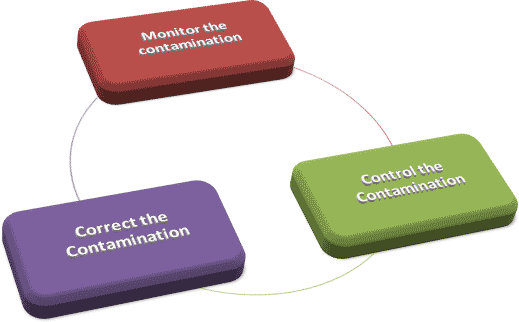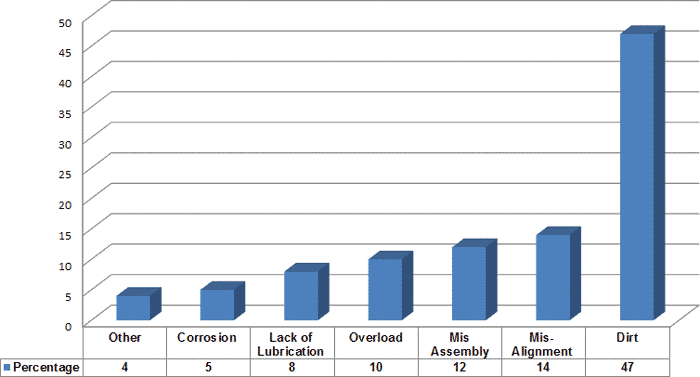Used Oil Analysis a Reliability Centered Approach
A machine’s operating life is most often determined by the oil that lubricates its load-bearing surfaces. Good lubrication normally provides long life, even under harsh operating conditions, and poor lubrication results in short life, even under mild operating conditions. Industrial machines are generally supposed to have 40,000 hours (about 5 years) mean time between failures (MTBF). This can only happen if you have “good lubrication”. If you have “poor lubrication” or “no lubrication” you get a far shorter operating life.
Reliability Centered Lubrication (RCL) is an approach to lubrication that is focused on designing a program for Lubrication and Oil Analysis by taking into account operational conditions, best practices, and modifications required to both machine and facility.
Current Maintenance Analysis | RCL planning | Implementation | Keep it on
Reliability Centered Lubrication (RCL) uses industry standard calculations to determine appropriate lubricant recommendations, including lube type, re-grease volumes, and re-lube intervals. Furthermore, the RCL process uses Failure Modes Analysis (FMA) to establish appropriate Oil Analysis test slates and test intervals.
It is important to understand that poor lubrication practices always results in high down time of equipment and reduce the machine availability. Poor lubrication practices include improper handling of lubes, wrong oil addition, wrong oil top ups, improper flushing of the reservoirs, tanks, etc. A small mistake like wrong oils addition would lead to great changes in viscosity of the lube in operation and can cause big damage to the equipment internals. Typically true with improper flushing practices before oil changes results in lubricant pre-mature degradation and can lead to increased wear.
How equipment fails?
The M.I.T. Study clearly indicates the root causes of surface degradation are improper lubrication, Lubricant contamination and mechanical problems on the machinery components. Furthermore lubricant health conditions in operating conditions are greatly affected by contaminations like air, water, process gases, leakages etc. From the M.I.T. study it is also evident that every wear particle generated has got a root cause and the root cause is very well connected to the equipment operating and loading conditions. Maintenance personnel need to look in to the way of how the lube oils are being degraded and equipment components are subjected abnormal wear with their operating environments and should implement a proper reliability centered maintenance approach to protect the lubricant health condition and there by the protection of critical assets from abnormal wearing resulting from these conditions.

The above study on common causes of bearing failures clearly indicates where we need to start from as far as the Reliability centered approach to take up. Out of all reasons 47% of bearing failures are due to dirt-contamination in the bearing oils. Hence the start point for RCA is nothing but to make sure to provide healthy, contaminant free lube oil to the components. Apparently the next root causes mis-alignment, mis-assembly issues, over load on the equipment components results wear particles generation and the next objective in RCA would obviously be Used Oil Analysis as these operating and mechanical wearing can be well detected by used oil analysis in the very early stages of failure. Even lack of lubrication, corrosion related issues can be well addressed with proper used oil analysis testing.
In Reliability centered maintenance, contamination control has got vital role in driving the operational goals like extending the oil drain intervals, systematic approach of oil top ups, increasing the machine availability.
There are 5 factors in maintaining good lubrication:
- Clean oil
- Dry oil
- Oil with the right properties
- Contamination Control
- Wear debris monitoring
 Contamination control is in-fact a 3 step cyclic process which include:
Contamination control is in-fact a 3 step cyclic process which include:
-
Monitoring the contamination- This starts from checking the incoming quality of lubricants, lubricants storage environment, proper usage of lube oil transfer containers, process environments etc.
-
Control the contamination - Once identified the source of contamination, one can take an immediate maintenance to control the incoming contamination and making sure a clean oil is flowing to the components. Remember only a clean, dry oil can give best lubrication to your equipment.
-
Correcting the contamination - Root sources of contamination to be identified and redesign the filtration procedures, breathers, vents, seals locations if necessary.

Used Oil Analysis, though it has got many objective t from the maintenance personnel perspective it should provide answers for
- data on the operating condition of the equipment
- The analysis results not only establish the condition of the oil but should also establish the condition of the equipment.
- Enables a predictive/Proactive strategy to be adopted
- Predictive – Actions performed in an attempt to predict/foresee a developing problem by providing systematic analysis.
- Proactive – Actions performed in an attempt to rectify a developing or existing problem by providing root cause analysis and diagnosis.
- Measurably Extend Life of Oil
- Measurably Extend Life of Equipment
- Increase Production/Machine Availability
- Reduce Maintenance expenses & Reduce Breakdowns
Fix the weak link- Vital task in starting Reliability centered approach to implement the Used Oil analysis.

RCA based Used Oil Analysis needs continuous improvement.
Any condition monitoring technique requires periodic data to interpret the exact condition of equipment. Used oil analysis starts with identifying the proper sampling locations, understanding of what testing measurements needs to be taken for each application, define the sampling frequencies on criticality based, interpreting the Oil Analysis results to your own operating conditions and taking appropriate maintenance actions on time.
What testing to take up & When to take up?
A general approach to the Used Oil Analysis for most critical equipment
Proper testing frequencies are essential for the success of getting benefited from used oil analysis. While selecting the sampling frequencies it is important to consider the type of equipment being monitored, oil change frequencies, criticality of the equipment, process environments etc.
Besides the routine oil analysis, there is a need based oil analysis testing required to be performed for better control over varnish related issues, corrosion based wear, cavitation effects, etc. This can be better guided by taking up the specific issues with OEM and professional oil analysis labs. Wear particles generation mode and size can tell you the operating modes and root causes of abnormal wear in equipment components at an early stages. Most OEM’s recommend Spectroscopy/Elemental analysis in their routine monitoring activities and ferrography/Wear Particle analysis is advised based on the severity of wear elements in spectroscopy. At Reliability centered approach it is recommended to carry out both ferrography and spectroscopy because spectroscopy cannot detect particles of size more than 8-10microns and ferrography acts like a value addition in understanding the exact severity of wear generation, generation mode, source of wear, etc. In certain complicated applications like aero engines even advanced techniques like Energy Dispersive X-Ray fluroscence(ED-XRF) spectroscopy is also recommended to find the exact component wear. Again filter debris analysis also serves a very important role to understand the large particle generation rate and severity.
| Oil Analysis Tests | Gears/Bearings | Hydraulics | Turbines/Compressors | Engines |
|---|---|---|---|---|
| Routine (Monthly or every 3 months depending on equipment criticality) | 1.Kinematic Viscosity @ 40,@100 deg.c & Viscosity Index 2. Moisture content 3. Total Acid Number 4. Ferrography Analysis 5. Spesctroscopy |
1.Kinematic Viscosity @ 40 deg.c 2. Moisture content 3. Total Acid Number 4. Particle count/NAS value 5.Spectroscopy analysis |
1.Kinematic Viscosity @ 40,@100 deg.c & Viscosity Index 2. Moisture content 3. Total Acid Number 4. Particle count/NAS value 5.Spectroscopy analysis |
1.Kinematic Viscosity @100 deg.c 2. Moisture content 3. Total Base Number 4. Flash point 5. Soot % 6. Spectroscopy analysis 7. Coolant dilution 8.Oxidation, Nitration, Sulphation |
| Once in a 6 months/ Need based | 1.Foaming Characteristics 2. Spectroscopy |
1. Emulsion Characteristics 2. Foaming Characteristics |
1. Ferrography 2. Emulsion Characteristics 3. Foaming Characteristics. |
1. Ferrography |
| Advanced tests once in a Year or as suggested by OEM/general practice | RPVOT for large sumps. Rust Prevention characteristics. | 1. RPVOT 2. Air release Value |
1. RPVOT 2. Air release Value 3. RULER & MPC |
1. Cylinder Scrape down analysis and any other tests suggested by OEM. |
 Interpret the oil analysis results that suits to your own operational conditions.
Interpret the oil analysis results that suits to your own operational conditions.
Do not just go by simple equipment tags Normal/Caution/Warning, in addition to this understand the reports why they tagged so because every sample tested that carries very useful and important information about the equipment wear, lubricant condition and contamination. It is very much possible to control certain physical properties, contaminants and wear particles by just changing or correcting the operating conditions and or maintenance practices. It helps to foresee certain types of abnormal wear that grow up in the system in the very early stages which can be corrected and or controlled by providing clean and dry lubricant.
 Conclusion
Conclusion
Reliability centered approach to the used oil analysis is a continuous improvement process in understanding the ongoing predominant abnormalities in the equipment’s at an early stages there by helps in understanding the root causes of failure. Many of the times RCA helps to reduce the severity of damage, reduce the secondary damage, increase the machine availability, reduce the break downs and maintenance expenses.
About the Author
K.N.V.Subrahmanyam is Chief Technical Officer at LubeXpert Labs Pvt.Ltd (A group company of AIMIL LTD) at Hyderabad. He is a Mechanical Engineer and did his Executive MBA in Oil & Gas Management. He is a certified Level-III Machinery lubricant analyst with over 15 years of experience in Industrial oil analysis, lubrication Management & Lube trainings. Specifically he is a subject matter expert in Ferrography analysis. Contact Subrahmanyam at subrahmanyamknv@aimil.com.
